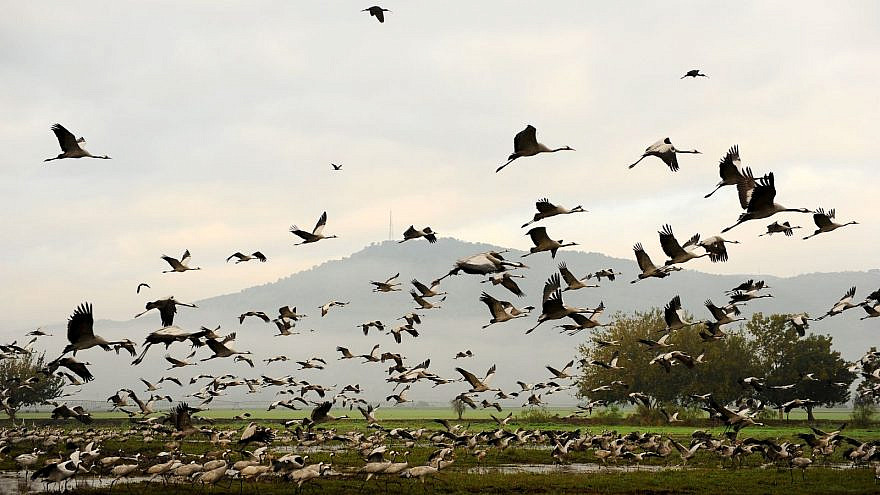If yours truly were asked to name all the birds she knows, she’d probably make it to about eight different types.
So you can imagine my surprise when I learned that there are no fewer than 220 bird species right here in Israel. Sure, some of them are rare, endangered or so specific that there’s little chance of knowing them … but still.
To get a bird’s-eye view of the topic and celebrate International Bird Day on April 1, I turned to Yoav Perlman, science director at the BirdLife Israel branch of the Society for the Protection of Nature in Israel.
Now, I can proudly share with you all I know about the birds of Israel, from the rarest to the most common.

Griffon vultures are veteran inhabitants of the land of Israel and are even mentioned multiple times in the Bible. They are huge creatures whose wingspan can reach more than eight feet and whose diet relies on carcasses. In recent decades, their numbers have dwindled to mere dozens, residing mostly in the Judean Desert. Among the reasons for this are poison scattered by cattle farmers, not against the vultures themselves; the extinction of their natural habitat; hunting; and power-line accidents.
These birds are so rare that in August last year, volunteers from the Israel Defense Forces’ Yahalom unit, fed a Griffon chick by drone for weeks after its mother was killed on power lines.
Golden eagle
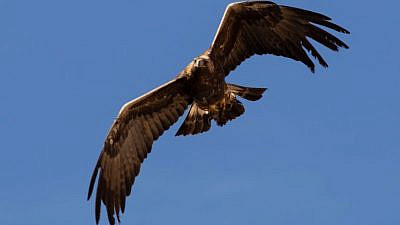
Another bird of prey in danger of extinction in Israel is the golden eagle—a big, strong bird with claws you don’t want to mess with. Only five to eight pairs remain, compared to the 35 to 45 pairs that were spotted in the country back in the 1980s.
“The condition of birds of prey in Israel is very bad,” says Perlman. “First of all, their populations are declining because of the decline in their habitat and its destruction. That means that they have less space, less food and they just disappear. Then there are more direct causes of death, such as electrocution, power lines, wind turbines, shooting and more.”
Houbara bustard
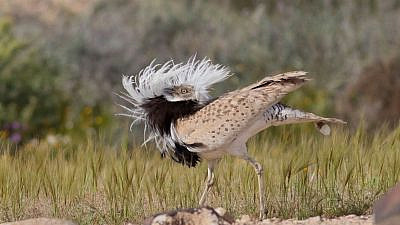
The houbara bustard is an endangered desert species that can be spotted by its distinct footprints. The population of houbara bustards in Israel stands at around 400. Houbaras are a flagship species, meaning it was chosen as a symbol for the state of all the plants and animals in its ecosystem. The birds are in danger due to mankind’s expanding activities in their natural habitat—from the building of new towns to the expansion of agricultural and solar fields.
Sandgrouse
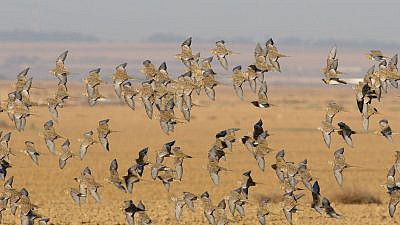
Like the houbara, the sandgrouse are ground-dwelling birds that reside in the flatter areas of the desert in Israel’s south. They are medium-sized and long-tailed and can be spotted from the ground by their white abdomens. There are a few hundred pairs of nesting sandgrouse in Israel. They are threatened by the expansion of human activity in the desert, such as agricultural fields, military firing areas and forestation.
Black-eared wheatear
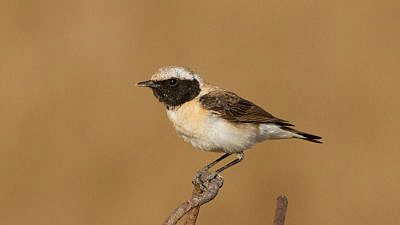
The black-eared wheatear is a small bird that summers in the forests of central and northern Israel and can be spotted by its distinctive black-and-white coloring (at least the males; female wheatears are a far plainer brown). Previously rather common in season, wheatears have been in rapid decline since the early 2000s and nowadays they are a rare sight. They sleep in ravines and under rocks, and as such are threatened by settlement expansion and human forestation efforts on the one hand and desertification on the other.
Nubian nightjars
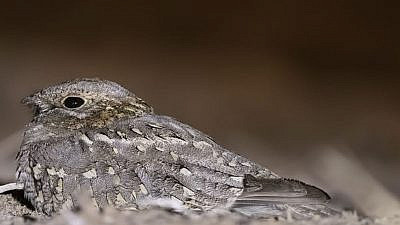
Asked what his favorite bird is, Perlman is hesitant to respond, because he truly loves them all. But he does have a special place in his heart for the Nubian nightjars that he researched. These are little nocturnal birds that live off flying bugs and whose males sound rather like barking dogs. They used to reside up and down Israel’s eastern border, but today are found in very small numbers, only near the Dead Sea.
“Their condition has improved in recent years but they’re still in danger of extinction. I’m very attached to them,” says Perlman.
Myna
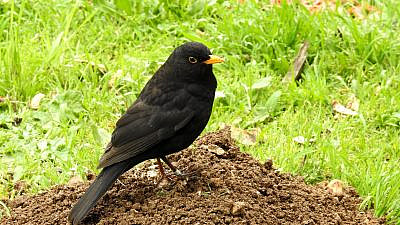
“Generally speaking, these are birds that have learned how to get along in the agricultural space in Israel, or in its rural or urban spaces,” he notes.
“There are a number of very successful invading species, especially in the last two decades,” he adds. “Some of them have become very prominent, such as the myna birds and monk parakeets, which have become common in urban and rural areas.”
Mynas, for example, took off in Israel when they escaped their safari cages towards the end of the 1990s and began thriving on manmade trash and leftovers. They are very musical and can often be heard singing tunes across the country.
Monk parakeet
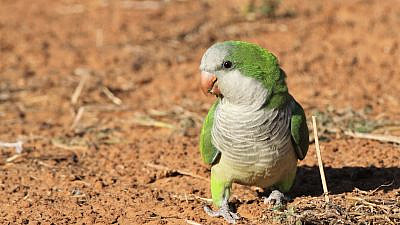
Like myna birds, monk parakeets are an invasive species that spread in Israel after escaping their safari cages and have since become a common sight in the country. The bright green creatures got their name from the shape of their head, which apparently resembles a monk’s headgear. Monk parakeets enjoy fruit and seeds, leading to concern among experts as to the damage they could cause to local agriculture.
Great tit

Great tit birds can be easily spotted by their bright yellow abdomen and black-and-white face, as well as by their rich singing voice. The little birds were originally found along the coastline in Israel, but unlike rarer counterparts on this list, they have benefited from expanded human activity and have made their way further south following settlement expansion over the years. They build their nests in pipes, mailboxes and vases, as well as in trees.
Blackbird
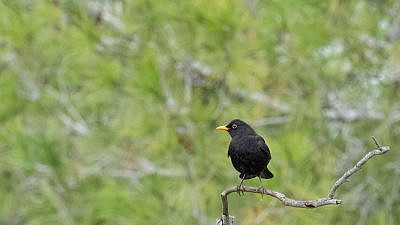
Like the great tit, blackbirds also inhabit Israel’s forests and therefore are doing pretty well.
“The Mediterranean forest in Israel is in quite good condition and even flourishing, so birds that reside there are in good condition,” explains Perlman.
As their name suggests, blackbirds are indeed black (the males, that is; the females are a reddish-brown color) and boast a long, rounded tail that moves in tune with their song. Blackbirds eat insects and worms and as such spend a lot of time poking and sweeping the ground to find food.
This article was originally published by Israel21c.




![Sa’ar: Israel must be free to act against Hezbollah truce violations Israel must continue to be able to deter Hezbollah, Foreign Minister Gideon Sa'ar stressed on Wednesday, speaking amid efforts to reach a ceasefire with Iran's Lebanese terrorist proxy. "We need to keep the freedom to act if there will be violations. And we will have to act in time, before the problem will grow," the minister told a gathering of nearly 100 foreign ambassadors in Jerusalem, the Times of Israel reported. A deal to end more than a year of fighting on the northern border must be durable, Sa'ar said, saying Jerusalem “would like to reach an agreement that will stand the test of time." He added that a ceasefire would be an "opportunity" for Lebanon to regain its sovereignty after the Israeli military severely degraded the Iranian-backed group in recent months. He called for the Lebanese Armed Forces to be strengthened and urged the international community to invest more in the economically devastated country, which is drowning in debt following years of mismanagement and corruption. Israeli Defense Minister Israel Katz also emphasized on Wednesday the necessity for Jerusalem to be able to act against any Hezbollah threats that may arise after a ceasefire deal is implemented. “The condition for any political settlement in Lebanon is the preservation of the intelligence capability and the preservation of the [IDF’s] right to act and protect the citizens of Israel from Hezbollah,” Katz said. Meanwhile, U.S. special envoy Amos Hochstein remained in Beirut for a second day on Wednesday to discuss "technical details" of an American ceasefire proposal with Lebanese Parliament Speaker Nabih Berri, who heads the Hezbollah-allied Amal movement. President Joe Biden's point man in the Land of the Cedars announced he would travel to Israel on Wednesday night, speaking after he made "additional progress" in a second meeting with Berri. Hochstein was scheduled to meet with Israeli Minister of Strategic Affairs Ron Dermer shortly after his arrival, followed by a tête-à-tête with Prime Minister Benjamin Netanyahu the following day. “The meeting today built on the meeting yesterday, and made additional progress,” Hochstein said. “So I will travel from here in a couple hours to Israel to try to bring this to a close if we can.” The Biden envoy added that he will work with the incoming Trump administration on ceasefire efforts, saying that he has kept the president-elect's transition team informed of progress. Hochstein described as "very productive" his meetings with Lebanese officials on Tuesday. “We have a real opportunity to end the conflict, and now is the moment to decide. We are committed to doing everything we can to work with Lebanon and Israel to end this conflict,” Hochstein said at a press conference on Tuesday. Hochstein also met on Tuesday with Lebanese caretaker Prime Minister Najib Mikati, and he was scheduled to meet with Lebanese Armed Forces commander Gen. Joseph Aoun. Mikati emphasized that Lebanon’s primary objectives are achieving a ceasefire and safeguarding its sovereignty. He highlighted the need to implement international resolutions and bolster the Lebanese Armed Forces in the southern part of the country. Lebanon delivered its written response to the latest U.S. proposal on Monday. According to Ali Hassan Khalil, an aide to Berri, the response included “comments” that were “presented in a positive atmosphere.” He did not provide details on the nature of the comments, saying only that they “affirm the precise adherence to [U.N. Security Council] Resolution 1701 with all its provisions,” according to Reuters. Hezbollah Secretary-General Naim Qassem said in a speech on Wednesday that the terrorist group had "read the ceasefire proposal. "We have our comments, and Nabih Berri has comments, and ours and the Lebanese government's comments are, Inshallah ['God willing'], identical," Qassem said. "We have decided not to discuss these ceasefire proposals or our comments in the media. All I will say is that Israeli is trying to obtain through negotiations what it couldn't through war." The terrorist leader vowed to “continue our efforts on the ground, whether the negotiations succeed or not. “We are confronting a savage enemy, and we will remain on the ground, no matter the cost, as we will also increase the cost for the enemy. We are facing Israeli human monsters supported by American human monsters,” threatened Qassem. Disarm and retreat Resolution 1701, which ended the 2006 Second Lebanon War, stipulated that Hezbollah must disarm and retreat north of the Litani River, but was never enforced. The Litani lies some 20 miles from the Israel-Lebanon border. Its enforcement, along with Israeli freedom of operation in Lebanon should Hezbollah violate the terms of a ceasefire agreement, are the key sticking points in the current negotiations. Netanyahu emphasized during a speech in the Knesset plenum on Monday that Israel will not allow Hezbollah to “return to the state it was in on Oct. 6, 2023. “We will be required, in order to ensure our security in the north, to systematically carry out operations—not only against Hezbollah’s attacks, which could come. Even if there is a ceasefire, nobody can guarantee it will hold. So it’s not only our reaction, a preventive reaction, a reaction in the wake of attack but also the capacity to prevent Hezbollah from strengthening,” he said. Hezbollah has launched some 16,000 rockets, missiles and drones from Lebanon at Israel since joining the war in support of Hamas on Oct. 8, 2023, a day after the Gaza-based terrorist group’s massacre in southern Israel. More than 60,000 residents of northern Israel remain internally displaced due to the ongoing rocket and drone attacks from Lebanon. Seventy-six people in northern Israel have been killed by Hezbollah cross-border rocket, missile and drone attacks since the start of the war, including 31 soldiers and six foreign citizens, according to the latest data provided by the Prime Minister’s Office, updated on Sunday. In addition, 729 people have been wounded, including 497 civilians and 232 soldiers. Of these, 29 civilians and 37 soldiers were severely injured; 63 civilians and 38 soldiers were moderately injured and 405 civilians and 157 soldiers were lightly injured. Hezbollah’s leadership has been left in tatters following a series of targeted killings by Israel, including that of Hezbollah leader Hassan Nasrallah in Beirut on Sept. 27. This was preceded by Israeli sabotage of Hezbollah communication devices that killed 39 people and wounded more than 3,400 members of the terrorist group. Israel has been waging a devastating aerial campaign against Hezbollah throughout Lebanon, including its stronghold of Dahieh south of Beirut. According to Israeli estimates, the terrorist group has lost most of its arsenal to the ongoing strikes. Then-Defense Minister Yoav Gallant said in late October that Hezbollah had lost an estimated 80%-plus of its long-range rockets since the start of the war. Israel also continues to battle Hamas terrorists in Gaza. The terrorist group still holds 101 hostages in the Strip, 97 of whom were kidnapped on Oct. 7. Many of the captives are believed to be dead. Brazil summit Meanwhile, G20 leaders gathered in Rio de Janeiro for a summit put out a joint statement on Monday calling for “comprehensive” ceasefires in Gaza and Lebanon. The leaders of the world’s biggest economies called for U.S. proposals to end fighting in Gaza and free the hostages, and one for Lebanon “that enables citizens to return safely to their homes on both sides of the Blue Line.” The 13-point U.S. proposal presented to Lebanese officials on Nov. 14 includes a 60-day truce, during which Lebanon would redeploy its troops along the border. The proposal also calls for Moscow to prevent Hezbollah from resupplying itself via Syrian land routes. Hezbollah would retreat north of the Litani River, with the border area then being under control of the Lebanese Armed Forces, overseen by the United States and Britain. Israeli officials are emphasizing, however, that the Israel Defense Forces must retain freedom of operation in Lebanon to thwart attempts by Hezbollah to violate the agreement and rearm and reestablish itself. A senior Israeli diplomatic official told Israel Hayom on Saturday that the IDF will retain operational freedom to respond to any security threats from across the northern border, regardless of any diplomatic arrangements. However, a source close to Hezbollah told The Washington Post that the group’s “condition for progress remains clear: Israel must be prohibited from conducting operations within Lebanese territory.” Berri emphasized at the time that any ceasefire agreement must not include the ability for Israel to attack by land, sea or air, Channel 12 reported. “Otherwise, what’s the purpose of an agreement?” he remarked. Another sticking point is Lebanon’s objection to the United Kingdom and Germany monitoring the implementation of U.N. Resolution 1701. Beirut reportedly favors the United States and France. If the ceasefire efforts fail, there are plans in the works to expand ground operations in Lebanon, an Israeli military official told the Post. Israel’s Strategic Affairs Minister Ron Dermer discussed the proposal with U.S. President-elect Donald Trump during a visit to his Florida estate earlier this month, as well as with senior Biden administration officials in Washington. Dermer also traveled to Russia to discuss the ceasefire proposal. Tehran is telling its Lebanese terrorist proxy Hezbollah that it supports ending the war against Israel, The New York Times reported over the weekend. Ali Larijani, senior adviser to Iranian Supreme Leader Ali Khamenei, met with senior Lebanese officials in Beirut on Nov. 15 to discuss the matter. Two Iranians affiliated with the Islamic Revolutionary Guards Corps told the Times that Larijani conveyed messages to Hezbollah from Khamenei that he supported the end of the war and that the regime would assist with rebuilding the terrorist group’s forces and recovering from the war.](https://jewishwebsite.com/wp-content/uploads/2024/11/Gideon-Saar-1320x880-2-218x150.jpg)





















